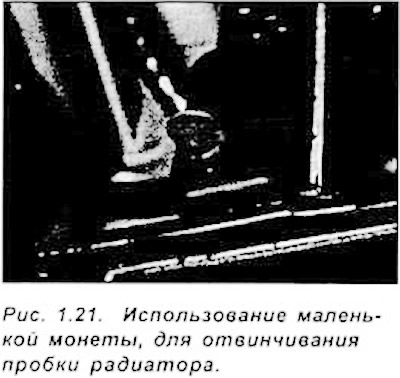Attention. If genuine Ford antifreeze is used, there is no need to change the coolant. When using conventional antifreeze, replacement must be done every two years.
Attention. Care must be taken when opening the expansion tank cap on a hot engine. as hot vapors escaping can cause severe burns.
Attention Do not allow coolant to come into contact with clothing and paintwork of the body, otherwise rinse the surface with plenty of water.
Coolant drain
Warning. Change the coolant only on a cold engine.
Remove the plug from the expansion tank. In the passenger compartment, set the heater temperature regulator to the maximum temperature position. If more work space is required, raise the front of the vehicle and secure it on stands. Unscrew the mudguard located under the radiator, which is fixed with 8 or 9 screws.
Place a suitable container under the radiator and unscrew the drain plug from the radiator pipe. You can use a coin to unscrew the drain plug (see fig. 1.21).

Flushing the cooling system
Drain the coolant, replace the radiator drain plug and fill the cooling system with fresh water. Install the expansion tank cap, start the engine and warm it up to normal operating temperature. Turn off the engine. let it cool down and drain the water from the cooling system. Repeat the operation of flushing the cooling system until the water comes out clean. Fill the cooling system with normal coolant.
To flush the radiator, drain the liquid from the cooling system, then disconnect the hoses from the base and upper tank of the radiator. Insert a garden hose into the top radiator hose. and run water through the radiator until water comes out clean from the nozzle at the base of the radiator.
To flush the engine, insert a garden hose into the water outlet of the thermostat, and run water through the engine until water comes out clean from the bottom hose.
Flush the heater radiator by first opening the heater cock and disconnecting the hoses from the heater. Connect a hose to one of the hoses and flush with clean water until water flows out of the second hose clean.
Coolant filling
After draining the coolant and flushing the cooling system, reinstall all previously removed hoses and secure them with clamps.
Fill the system slowly through the expansion tank as the tank is at the highest point in the system and all air in the system must be forced into the tank by the fill fluid. Slowly filling the cooling system with liquid reduces the possibility of air pockets. Fill coolant up to the MAX mark on the expansion tank. If there are air pockets in the cooling system, they can be removed by compressing various hoses.
Start the engine and warm it up at idle. If the liquid level in the expansion tank decreases, it is necessary to add coolant.
Checking the tightness of the cooling system
Coolant leaks can be identified by the presence of white deposits.
Bending and squeezing the hoses and nozzles, check them for cracks and elasticity.
Check the installation of hoses on fittings and their fixation with clamps.
Noticeable loss of coolant in the presence of traces of engine oil in it, as well as white smoke from the exhaust pipe, indicate a burnt cylinder head gasket, which must be replaced.
Visitor comments